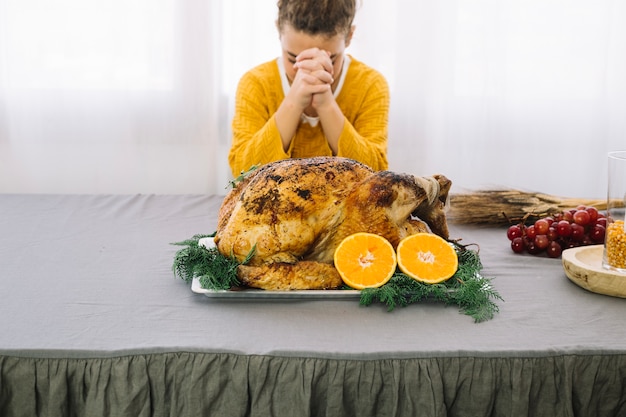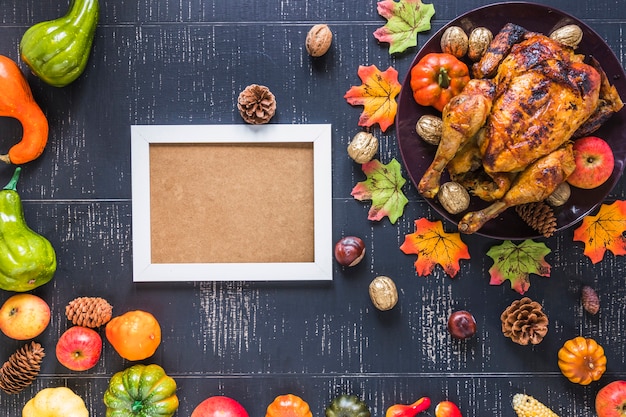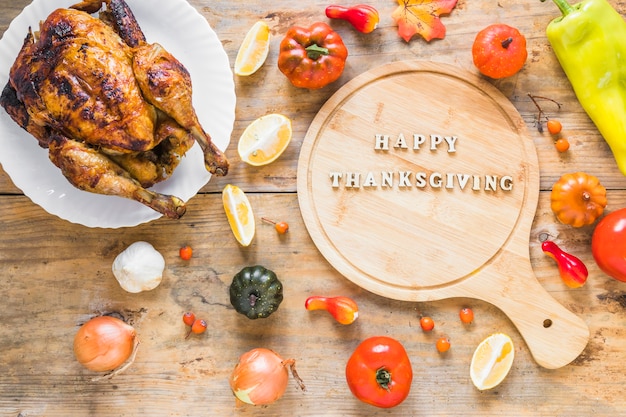Ah, the holidays! The air is crisp, the decorations are up, and the scent of pine needles fills the air. It's a time for family, friends, and of course, a delicious feast. And at the centre of that feast, the undisputed star, is the turkey. As a seasoned cook, I've spent many holidays perfecting my turkey roasting skills, experiencing both triumphant moments of juicy, golden birds and the occasional disappointment of dry, overcooked disasters. But don't worry, my fellow cooks! I'm here to guide you through the process, sharing my hard-earned wisdom and helping you create a turkey that will leave your guests raving.
This isn't just any ordinary turkey guide. We'll delve into the science behind roasting, unraveling the secrets to achieving that perfect balance of tenderness and flavour. We'll tackle the common pitfalls that even seasoned cooks can fall into, and equip you with the knowledge and confidence to cook a turkey that's the envy of the neighbourhood.
(Part 1) Choosing Your Bird: The Foundation of a delicious turkey

Before you even start thinking about oven temperatures or basting techniques, you need to choose the right bird. This might seem straightforward, but there are some important considerations to make for a truly delicious turkey.
Choosing the Right Size
The first rule of thumb is to plan for about 1lb of turkey per person. Don't forget to account for leftovers – those turkey sandwiches on Boxing Day are a tradition for a reason! For a crowd of 10-12, a 12lb bird will do nicely. If you're expecting 15-18 guests, a 18lb turkey will be your best bet. Now, I know it can be tempting to go for a massive bird, but remember, you'll need a roasting pan big enough to hold it! You don't want to overcrowd your oven; it will affect the cooking time and the evenness of the roast. Sometimes, a slightly smaller bird might be the better choice for your oven space.
Fresh or Frozen?
This is a matter of personal preference, but I've always favoured fresh turkeys. They have a richer flavour and a tender texture. Plus, there's no thawing involved, which means one less thing to worry about! However, frozen turkeys are perfectly fine and often readily available. Just remember to plan ahead and defrost it in the fridge for a few days, following the manufacturer's instructions. No one wants to be scrambling at the last minute with a partially frozen turkey!
The Turkey Check-Up: Looking for Quality
Before you bring your turkey home, take a moment to give it a good look over. A plump, well-shaped breast and legs that are free from bruises or discolouration are a good sign. Avoid any turkey that feels limp or has an unpleasant odour. A fresh, high-quality bird will have firm, springy flesh and a clean, pleasant aroma.
(Part 2) Preparing Your Bird: Getting Ready for Roasting

Now that you've chosen your perfect turkey, it's time to get it prepped for roasting. A few simple steps will ensure a beautifully cooked bird that will be the star of your holiday table.
Brining: A Game Changer
Brining is a game-changer for turkey roasting. It involves soaking the turkey in a salt-water solution for several hours. The salt draws moisture into the meat, making it juicier and more flavorful. I've been a brining convert for years, and I can't imagine roasting a turkey without it. It elevates the bird to a whole new level of deliciousness! You can create a basic brine with salt, sugar, and herbs, or go for a more complex recipe. The key is to let the turkey soak for at least 4-6 hours, or even overnight, in the fridge. Just remember to remove the turkey from the brine and pat it dry before roasting.
Stuffing: A Debate with a Delicious Outcome
Whether you stuff the turkey or cook the stuffing separately is a matter of personal preference. There are pros and cons to both methods. stuffed turkeys can be incredibly delicious, but they require a longer cooking time and need to be cooked to a higher temperature to ensure the stuffing is safe to eat. This can lead to a drier bird. Cooking the stuffing separately offers more flexibility and allows you to cook it to a safe temperature without overcooking the turkey. Whichever method you choose, make sure the stuffing is cooked thoroughly before serving. Personally, I prefer to cook my stuffing separately; it allows for more even cooking and prevents any overcooking of the turkey.
The Final Touches: Seasoning and Trussing
Once your turkey is prepped, it's time to season it. A simple rub of salt, pepper, and herbs is all you really need. Feel free to get creative with your seasoning blend, adding paprika, garlic powder, or even a touch of citrus zest. I've found that a simple blend of salt, pepper, and rosemary works beautifully. Finally, truss the turkey by tying the legs together with kitchen twine. This helps the bird cook evenly and prevents the legs from drying out.
(Part 3) Choosing Your Roasting Method: A Tale of Two Ovens

Your turkey is prepped and ready to go, but how will you roast it? There are two main options: traditional oven roasting or a more modern approach using a rotisserie.
Traditional Oven Roasting: A Tried-and-True Method
This is the classic way to roast a turkey, and for good reason. It's simple, reliable, and produces a beautiful, golden bird. The key to success lies in selecting the right temperature and cooking time, and ensuring the turkey is roasted evenly. We'll delve into those details in the next section.
Rotisserie Roasting: The Art of Spinning for Perfection
Rotisserie ovens offer a different approach to roasting, with the turkey spinning on a spit while it cooks. This method is particularly effective for larger turkeys, as it ensures even cooking and often produces a crispier skin. However, you'll need a rotisserie oven or a special rotisserie attachment for your existing oven. If you're considering this method, do your research and make sure you're comfortable with the process.
(Part 4) Mastering the Roasting Process: Achieving Turkey Perfection
You've got your prepped turkey, your oven is ready, and now it's time to dive into the roasting process. This is where the real magic happens, and where a little know-how goes a long way.
Setting the Temperature: The Foundation of Success
The ideal roasting temperature for a turkey is 325°F (160°C). This temperature allows for even cooking and helps the turkey to brown nicely without drying out. I've found that sticking to this temperature is crucial for a delicious and juicy bird. Resist the temptation to crank up the heat, as this will lead to overcooked and dry meat.
Calculating Cooking Time: A Guide for Accuracy
The cooking time for a turkey depends on its size and weight. A general rule of thumb is to allow 15 minutes per pound for an unstuffed turkey, and 20 minutes per pound for a stuffed turkey. However, it's always best to use a meat thermometer to ensure the turkey is cooked through. We'll discuss the importance of temperature monitoring in more detail later.
The Importance of Basting: Keeping It Moist
Basting is a crucial step in roasting a turkey. It involves spooning pan juices over the bird throughout the cooking process, helping to keep it moist and flavorful. I always use a basting brush for this, applying the juices generously every 30-45 minutes. Basting is a simple yet effective technique that makes a big difference in the final result.
Resting: Allowing the Juices to Redistribute
After the turkey is cooked through, it's essential to let it rest for at least 15-20 minutes before carving. This allows the juices to redistribute throughout the meat, resulting in a more tender and juicy bird. I always cover the turkey loosely with aluminum foil while it rests. This helps to keep it warm and prevents the skin from drying out.
(Part 5) Temperature Monitoring: Ensuring a Safe and Delicious Turkey
One of the most important aspects of turkey roasting is temperature monitoring. Using a meat thermometer allows you to ensure the bird is cooked through and safe to eat. A digital thermometer is the best choice, as it provides accurate readings and is easy to use.
Don't Rely on Appearances: Trust the Thermometer
I've learned the hard way that relying on visual cues alone can be misleading. A turkey might appear golden brown and cooked, but the inside might still be undercooked. A meat thermometer is the only reliable way to ensure the turkey is safe to eat. It takes away the guesswork and provides peace of mind.
internal temperature Targets: Safety and Juiciness
The USDA recommends cooking turkey to an internal temperature of 165°F (74°C) in the thickest part of the thigh. This temperature ensures that all harmful bacteria are killed. However, I find that cooking the turkey to a slightly lower temperature, around 155°F (68°C), produces a more juicy and tender bird. This is a personal preference, but if you're aiming for a juicy turkey, I recommend checking the temperature at 155°F and then using the "carryover cooking" effect to reach the safe internal temperature.
The Carryover Cooking Effect: A Helpful Tool
When you remove the turkey from the oven, it continues to cook due to the internal heat. This is known as the carryover cooking effect. It can take several minutes for the turkey to reach the safe internal temperature after it's been removed from the oven. Keep this in mind when monitoring the temperature. If you're aiming for a 165°F internal temperature, check the temperature at 155°F and let the turkey rest for a few minutes before checking again.
(Part 6) Avoiding Common Pitfalls: Troubleshooting Turkey Roasting
Turkey roasting can seem daunting, but it's really quite straightforward. With a little planning and attention to detail, you can avoid common pitfalls and ensure a delicious outcome.
Overcooking: A Common Mistake with Serious Consequences
Overcooking is one of the most common mistakes people make when roasting a turkey. It leads to dry, tough meat that nobody wants to eat. The culprit? Leaving the turkey in the oven for too long. Always check the internal temperature with a meat thermometer to ensure it's cooked through without being overcooked. I've learned the hard way to trust the thermometer and not rely on visual cues alone.
Uneven Cooking: Preventing Dry Spots
Uneven cooking is another potential issue. This can happen if the turkey is overcrowded in the oven or if it's not roasted evenly. To prevent this, ensure your turkey has enough space to cook evenly. Rotate the bird halfway through the cooking process to ensure all sides are exposed to heat. Basting also helps to promote even cooking and prevent dry spots.
The Importance of Resting: Let It Relax
Don't be tempted to carve the turkey right out of the oven. It needs time to rest and redistribute its juices. Skipping this crucial step can result in a dry and disappointing bird. Allow the turkey to rest for at least 15-20 minutes before carving. The juices will redistribute, leading to a more tender and juicy turkey.
(Part 7) Serving Your Roasted Turkey: Presenting a Culinary Triumph
The final step is serving your roasted turkey, the crowning glory of your festive feast. This is where your hard work and dedication pay off, and where you can present a culinary triumph.
Carving with Confidence: A Skill to Master
carving a turkey can seem daunting, but it's actually quite simple. Use a sharp carving knife and a carving fork to separate the breast meat from the bones. Cut the breast meat into slices, and then remove the legs and thighs. The dark meat can be carved off the bone or left whole. Practice makes perfect, and with a little patience, you'll be carving like a pro in no time.
The Art of Presentation: A Feast for the Eyes
The way you present your roasted turkey can make all the difference. Arrange the carved meat attractively on a platter, alongside your favorite side dishes. I like to create a centerpiece with the breast meat, surrounded by the legs and thighs. The presentation can be simple or elaborate, depending on your preference and the occasion. Remember, the turkey is the star of the show, so make sure it shines!
Savoring the Fruits of Your Labor: The Joy of Sharing
Finally, it's time to savor the fruits of your labor and enjoy the delicious turkey you've created. Gather your loved ones around the table, share stories and laughter, and appreciate the delicious meal you've prepared. The joy of sharing a home-cooked meal with friends and family is what makes it truly special. And that, my friends, is the true meaning of a flawless festive feast.
(Part 8) FAQs: Your Turkey Roasting Questions Answered
Now that you've armed yourself with the knowledge to cook a perfect turkey, let's address some frequently asked questions.
1. Can I Cook a Frozen Turkey?
Yes, you can cook a frozen turkey, but it's important to defrost it properly first. Defrosting a turkey in the refrigerator is the safest and most recommended method. Allow 24 hours of defrosting time for every 5 pounds of turkey. For example, a 12-pound turkey will take approximately 48 hours to defrost in the refrigerator. You can also defrost a turkey in cold water, but this method requires careful monitoring and is not as recommended as refrigerator defrosting.
2. What if My Turkey is Overcooked?
If you've overcooked your turkey, don't despair! While it might not be as juicy as a perfectly cooked bird, it can still be delicious. The overcooked meat will be drier, so you can try to compensate by adding a sauce or gravy. You can also serve the overcooked turkey in a dish that hides its dryness, such as a turkey pot pie or a turkey salad. However, it's best to avoid overcooking in the first place by carefully monitoring the temperature using a meat thermometer.
3. Can I Roast a Turkey with Stuffing Inside?
Yes, you can roast a turkey with stuffing inside, but it's important to do it safely. The USDA recommends cooking stuffed turkeys to an internal temperature of 165°F (74°C) in the stuffing. This higher temperature ensures the stuffing is cooked thoroughly and safe to eat. However, stuffed turkeys take longer to cook, and the stuffing can dry out the bird. I personally prefer to cook my stuffing separately, which allows for more even cooking and prevents the turkey from becoming dry.
4. How Long Can a Cooked Turkey Sit Out?
A cooked turkey should be refrigerated within two hours of being cooked. It can be safely left out at room temperature for up to two hours, but it's best to refrigerate it as soon as possible. This helps to prevent bacteria growth and ensure the turkey remains safe to eat. A refrigerator-safe turkey can last for up to four days. To reheat a leftover turkey, you can bake it in the oven, cook it in the microwave, or use it in a soup or casserole.
5. What Are Some Delicious Side Dishes for Turkey?
There are endless possibilities for delicious side dishes to accompany your roasted turkey. Some classic choices include mashed potatoes, gravy, cranberry sauce, stuffing, green bean casserole, sweet potato casserole, and rolls. You can also get creative with seasonal vegetables, such as roasted brussels sprouts, butternut squash, or asparagus. Remember, the side dishes are an important part of the feast, so choose options that complement the flavors of the turkey and create a balanced and enjoyable meal.
I hope this guide has been helpful and has inspired you to confidently tackle turkey roasting. Remember, it's all about practice, patience, and a touch of culinary creativity. Embrace the process, enjoy the journey, and most importantly, savor the delicious results!
Everyone is watching

Corn on the Cob: The Ultimate Guide to Perfectly Cooked Ears
Healthy MealsAh, corn on the cob. Just the name evokes images of sunny days, barbecues, and that sweet, juicy flavour that ...

Perfect Pork Roast Oven Cooking Time: A Guide to Delicious Results
Healthy MealsThere's something truly satisfying about a perfectly roasted pork. The aroma alone is enough to make your mout...

Scallops: The Ultimate Guide to Perfect Cooking
Healthy MealsAh, scallops. Those delicate, sweet, and utterly delicious morsels of the sea. They hold a special place in my...

Ham Cooking Time: How Long to Bake, Smoke, or Boil a Delicious Ham
Healthy MealsAh, ham. It's a classic, isn't it? A real crowd-pleaser, especially around holidays. And when done right, it'...

Spaghetti Squash: The Ultimate Guide to Cooking and Serving
Healthy MealsRemember that time you saw spaghetti squash at the supermarket, looking all bumpy and strange, and thought, "W...
